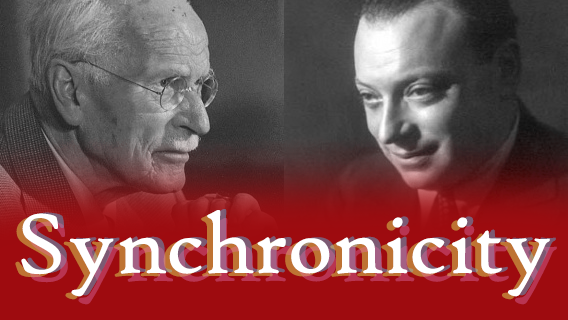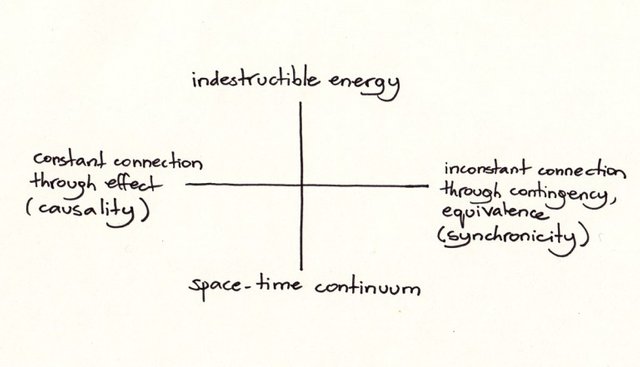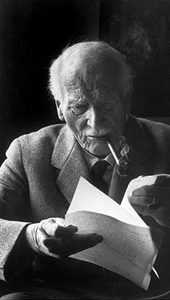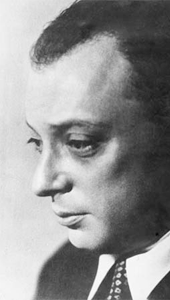Carl Gustav Jung, Wolfgang Pauli & their idea of SYNCHRONICITY. A unique marriage of psychology and physics
A star fall, a phone call,
It joins all,
Synchronicity.
The Police - "Synchronicity"
The subject discussed in this article is very complex and I will present it quite vaguely and as simply as possible. As a psychologist by education I do not have too much knowledge of physics, but I will try to write nothing contrary to the truth. I ask any stem minds for a correction If something's wrong. Thank you @galott and @bendelgreco for your inspiration and motivation to write this article!

Two Ingenious Minds
The main heroes of this article are two great minds. Minds not only extremely intelligent, but also exceptionally open. Both Jung and Pauli were not afraid to go beyond the frames fixed rigidly by the scientific backgrounds of their origins. In spite of the fact that the fields they dealt with were completely different (or on the contrary!), their motivations were similar. Both in an almost desperate way tried to understand w h a t is this world, w h a t is the true nature of reality? Both of them were guided by intuition, a bit of madness, creativity and voices of their hearts. Both of them presented extremely courageous, almost unimaginable hypotheses, creating an aura of mystery and controversy around them (especially in the scientific community). One might think that the fate had to bring those two souls towards each other in the end. That is what actually happened. And from this meeting something completely unexpected was born - a concept that was more courageous, crazy and unthinkable than everything they had done before. Synchronicity.
Yet before this, a brief description of their accomplishments.
Carl Gustav Jung
The best-known pupil of Freud, his would-be successor. He decided to choose a more difficult and, quite lonely, path - he chose to trust his intuition and, contrary to the trends in science at that time, to base his psychology on phenomenology and traditional German empiricism. Creator of analytical psychology - therapeutic orientation and a set of hardly verifiable hypotheses on the functioning of human psyche and its relations with culture, religion and symbols. Accused of mysticism, cult, religion, creating art or pseudo-science rather than science. Nevertheless, some of his discoveries and hypotheses function in academic psychology nowadays, even the most controversial ones (e.g. archetypes are being reinterpreted, based on new discoveries in the field of neuroscience or other fields of psychology that are better rooted in the scientific method than analutical psychology.
Wolfgang Pauli
A brilliant, charismatic and somewhat eccentric physicist. One of the creators of quantum mechanics. He expanded our understanding of fermions (e.g. electrons) thanks to the rule he proposed, which was later named Pauli exclusion principle for which he received the Nobel Prize in physics in 1925. This discovery made it possible to understand the periodical structure of elements and is the basis for knowledge about spins in contemporary quantum physics. He also proposed a hypothesis of existence of neutrino, which was confirmed after 36 years!
Two Personalities Reaction
The meeting of two personalities is like the contact of two chemical substances: if there is any reaction, both are transformed.Carl Gustav Jung
Pauli was known for his deepening into the problems of natural philosophy, that is philosophical issues dealing with the subjects of nature, time, space, matter, mathematics and finally mind and consciousness (and relations of all these elements). In correspondence published after his death, these topics can be found frequently. He also focused on the history and development of ideas created by man, not only from the western world, but also from the far east or from hermetic and occult sources.
In the fourth decade of his life he experienced a serious emotional crisis, accompanied by extremely intense dreams and at times also symbolic visions. Upon his father's persuasion, he turned for help to Carl Gustav Jung, a Swiss psychiatrist who was already recognized at that time, reaching the age of 60. Initially therapeutic relationship began to take on the philosophical-scientific character of mutual inspiration. Intensive dreams and rich symbolism of Pauli's mind were used by Jung to illustrate the process of individuation. Their common interests finally led them to work on the extraordinary phenomenon of synchronism...
Synchronicity
Phenomenology of Synchronicity
CNNN describes the unusual case of Royce Burton, who perfectly shows what synchronicity is:
Royce Burton was teaching history at a New Jersey university when he decided to tell his class about a frightening experience he had as a young man.
He was a Texas Ranger, patrolling the Rio Grande in 1940, when he got lost in a canyon after dark. He tried to climb out but lost his balance just as he neared the top of a cliff. Suddenly Joe, a fellow Ranger, appeared and hoisted him up to safety with his rifle strap. Burton thanked Joe for saving his life but lost contact with him after both men enlisted in the military during World War II.
Burton was in the middle of sharing his story when an elderly man appeared in the doorway. It was Joe, the fellow Ranger. He had tracked Burton down 25 years later and walked into his classroom at precisely the moment Burton was recounting his rescue.
"I'll have Joe finish the rest of the story," Burton said, without missing a beat as the astonished classroom witnessed the two men's reunion.
A similar case allegedly occurred in the case of the French writer Émile Deschamps. Reportedly in 1805, a stranger named Monsieur de Fontgibu served him a plum pudding. When Deschamps decided ten years later to order the same pudding in the restaurant, it turned out that the last portion was ordered by someone other than Monsieur de Fontgibu. What's more, in 1832 he ordered plum pudding at dinner with his friends again and told this extraordinary story to his them when exactly in that moment Monsieur de Fontgibu entered the room!

Cetonia aurata
perpetrator of the fuss in the Jung' cabinet
image source
Jung defined synchronicity as phenomena, which manifests itself in a significant coincidence between the psychological (subjective) world and the material (objective) world. These are events whose probability of parallel coexistence as well as a causal connection seems unimaginably low. He was originally concerned only with the phenomenological side of synchronicity, its psychological impact on man and its connection with archetypes. He saw a huge therapeutic potential in the fact that internal symbolic images sometimes paralel with events from the outside world and evoke a powerful sense of meaning in this coincidence. He observed how profound change in man can cause such an event, sometimes leading to revaluation of their values and beliefs.
Interestingly, there were many strange synchronicities occurring around Pauli, which later even gained a name - Pauli's effect. When Pauli arrived in a physics laboratory, usually one of the specialist apparatus simply broke down. The most interesting synchronicity of the "Pauli effect" happened to James Franck, who's special atomic measuring equipment one day just broke down. He wrote about this event to Pauli, who later revealed to him that he was on the train that day, which stopped in the same city where Franck's laboratory was located exactly when his equipment had broken down! Similar cases appeared several times, some physicists even forbade him to enter their laboratories!
A Shift Towards Ontology
Jung was actually the only psychologist/psychiatrist at that time to have any relationship with physicists. When at the beginning of the 20th century, after numerous exchanges of ideas with Albert Einstein and meeting Wolfgang Pauli he understood how much new physics change the perception of our world, he believed that with this paradigm shift in physics it would also happen in psychology (which, looking from a hindsight, did not happen). He saw this as an opportunity to place his analytical psychology in a broader scientific context. Pauli and Jung started exploring the topic of synchronicity and its potential connection with the discoveries of quantum mechanics and relativity theory.
The joint conclusions of Pauli and Jung go far beyond their original fields and enter the area of philosophy of nature and ontology. Jung and Pauli's thinking revolved around the nature of mind and matter and their mutual relationship. Both speculated that at a deeper level mind and matter are two different aspects of the same reality, and thus may be subject to similar laws. Jung expressed such a view on the nature of reality as Unus mundus (one world) and this term was taken from the alchemical texts he studied.
Researchers have come to the conclusion that the phenomenon of synchronicity can have a deeper nature than merely phenomenological meaning created by a prone mind. What if there are some specific laws of nature that structure both matter and mind so that they can "meet" which results in the experience of synchronicity? To illustrate the conclusions of Jung and Pauli, let us take liquids and crystals. Liquids have a "inscribed" structure of crystal within them. They have the potential of a specific form, which in appropriate conditions simply materializes. They do not need any external force to put solid particles into a specific crystal pattern - this happens spontaneously.
What if there is a principle of reality that structures matter and mind regardless of causality? What if matter and mind - as two different states of the same reality - have an "inscribed form" like liquids and this form is revealed from time to time in the form of extraordinary coincidences? So far, the only-deterministic view of the world has burst under the influence of quantum theory, so the gentlemen started to take into account that apart from causality it is also possible that some kind of acausality exists.
In other words - perhaps synchronicity cannot be explained by classical physics (or just by coincidence). One can look at synchronicity as a quasi-quantum entanglement between matter and mind. In the 21st century, even such crazy ideas are coming up as that the human psyche is part of a larger quantum field and that the mind can exchange some kind of "mental bosons" that are responsible for synchronous phenomena (e. g. Baaquie and Martin, 2005).

image source
“We must postulate a cosmic order of nature beyond our control to which both the outward material objects and the inward images are subject.” wrote Pauli, seeing the probabilistic character of quantum theory and Heisenberg's uncertainty principle something that somehow may fill the scientific gap between mind and matter. He suggested that quantum processes may somehow "acausally weaves meaning into the fabric of nature."
Therefore, Jung and Pauli saw nature as a single, psycho-physical whole, where the two worlds (historically considered separately thanks to Descartes) are closely intertwined and interact with each other. Pauli suggested that probability in nature and mathematics reflects what is manifested psychologically as an archetype. Jung came to the conclusion that numbers, like Platonic ideas, are the basic "archetypes" of reality, which structure both matter and the psychological world in equal degree (idea later expanded by his pupil Marie-Louise von Franz). On the basic concepts of natural numbers may various symbolic representations "enlarge" in phylogenesis and culture, which later became apparent in religious, mythological or dramatic stories. In one of his letters Jung wrote to Pauli:
These [the natural numbers] seem to be the simplest and most elementary of all archetypes. That they are archetypes emerges from the psychological fact that simple whole numbers, given the chance, amplify themselves
immediately and freely through mythological statements; e.g. 1 = the One, absolute, nondivisible . . . and thus the unconscious, the beginning, God, etc. 2 = the division of the One, the pair, the connection, the difference (agens-patiens, masculine-feminine, etc.), counting, etc. 3 = the renaissance of the One from the Two, the son, the first masculine number, etc.
The hypothetical principle of some layer of reality binding all the remote fragments of reality, existing alongside the causality principle can theoretically be attributed to many paranormal phenomena observed in the world. Of course, even if synchronicity is more than just a result of coincidence, it does not imply the existence of anything supernatural. Jung and Pauli treated this as a neutral law of nature rather than divine interference.
Summary
Causality may be considered as a mode of perception by which we reduce our sense impressions to orderNiels Bohr
The common thoughts of Jung and Paul went far beyond physics and psychology, entering the area where these two areas are transformed into a speculative philosophy of nature. The gentlemen were well aware of the unverifiable nature of their deliberations and did not try to convince the world of their reasons. But they really believed, that an ordinary principle of causality is not enough to reliably describe principles that govern the universe. Of course, this idea was not very widely accepted by the scientific community. Most critics say that synchronicity can be explained by the law of large numbers, which says that in really large populations unusual phenomena simply happens. And when they happen, they are widely reported and shared. Others say that synchronicity is the result of the human mind's constant desire to give events and the reality a meaning, so it is supposed to be the result of creating connections full of meaning between random events.
What's the truth? Hard to say. The idea of synchronicity possesses something appealing. I think everyone of us, however rational might be, would like to see the world as a harmonized whole. Perhaps that's why synchronicity has inspired and inspires many minds to this day. For this reason it is often thrown into a single bag with a new age or mysticism. Is it right category for what Pauli and Jung thought? I'm not in a good position to judge that!
Surely most of you have experienced synchronicity. Share your story in a commentary!
Literature
Atmanspacher, H., & Primas, H. (2009). Recasting Reality.
Baaquie, B. E., & Martin, F. (2005). Quantum psyche: Quantum field theory of the human psyche. NeuroQuantology, 3(1).
Emile Deschamps, Oeuvres completes : Tomes I–VI, Reimpr. de l'ed. de Paris 1872–74
Donati, M. (2004). Beyond synchronicity: the worldview of Carl Gustav Jung and Wolfgang Pauli. Journal of Analytical Psychology, 49(5), 707-728.
Jung, C. G. (2010). Synchronicity: An Acausal Connecting Principle.(From Vol. 8. of the Collected Works of CG Jung)(New in Paper). Princeton University Press.
Jung, C. G., & Pauli, W. E. (2012). The interpretation of nature and the psyche. Ishi Press International.
Mansfield, V. (1995). Synchronicity, science, and soul-making. Chicago: Open Court.
Von Franz, M. L. (1974). Number and time. Northwestern University Press.

SteemSTEM is a community driven project which seeks to promote well written/informative Science Technology Engineering and Mathematics postings on Steemit. More information can be found on the @steemstem blog. For discussions about science related topics or about the SteemSTEM project join us on steemSTEM chat.


Being A SteemStem Member
Ah, such a fascinating topic. I like to consider myself as a natural philosopher and regret the term and practice has slipped away for the most part in our modern culture. Synchronicity: this is a phenomenon that becomes an almost constant experience for those who have attained certain degrees of higher consciousness. Awareness of synchronicity is always fascinating and fun! The enlightened ones literally experience the totality of synchronicity of all things... all things being One. Time, which is a function, I believe, of frequency dissolves into one constant no-time. This is the state of pure synchronicity. Look forward to more stimulating posts. Oh, and as far as numbers/math/geometry, etc., being the code or language of the Cosmos: indeed it is. And once again the enlightened masters have experienced and "seen" the Cosmos from this perspective. Many blessings. Oh! Here is a rather simple poem I wrote years ago, but not very deep at all. More from a sense of awe.SYNCHRONICITY
By Christopher
I do not know how in a Universe
So incredibly complex and vast
And stunningly beautiful,
One star,
Your incandescent flaming soul,
Can be so exquisitely timed in its' movements;
How, among the swirling colors,
And brilliant lights,
And endless energies,
How, among the limitless kaleidoscope of possibilities,
There is perfection of synchronicity.
Thank you for sharing your experience with synchronicity :)
Great post. When we talk about synchronicity, we enter in a grey area of the so called Unus Mundus. Jung said that there was a certain level of the unconscious where the psyché and the world could communicate, that would be the grey area that merges psyche and world, maybe in the "anima mundi".
It's amazing that synchronicity can achieve astonishing levels of coincidence, as in the examples mentioned in the text, but it can be seem too in facts that deal with the person's symbolic significance (maybe this is more of an Archetypal Psychology matter). This can happen in a way that only the person knows the significance of the fact, what is amazing too.
I believe that the occurrence of several synchronicities means that we are in the "right" direction towards individuation. They also can point to what contents are particularly strong in our unconscious.
For me it is not as much an amazing feature, as one of the sources of my skepticism towards the idea of synchronicity (as fascinating as it is, I have to admit, it's great topic and article). Because we are beings that easily spot patterns, connections and imply casuality. It is our bias. So if only one person perceives something as "supernatural", then maybe it's just an illusion coming from the fact, that we love to spot patterns in the world and assign meaning to meaningless, especially when it comes to things that touch us, we overestimate the importance of ourselves I would say. Even if those patterns are result of randomness, then we think there is some purpose, or in this case "synchronicity" that created this situation, not pure randomness. Think about the people that claims they saw face of Jesus in the shape of clouds, in the shape of tree trunk.
I understand. In this case, we could talk about this pattern recognition as deep rooted in the archetypal basis (this numinous structure in its relation with the images). Sometimes the synchronicity lies exactly in this random subjectivity as we are dealing with te signification of an image (primacy of the signifier). One can see Jesus in the shape of a tree trunk, and what matter isn't if the trunk is in fact Jesus, but what this could say to the people's psyche. Of course one can say "so there is no miracle, because it is just the person relating to her own mind!", but in this area of psychology we deal with the notion that our ego/consciense isn't the "house owner", but lives with several complexes and images that are autonomous in a certain way. I don't discard the ocurrence of supernatural events or physical manifestations, but I'm saying that it can be a matter of what the Image awaken in us or the "symbolic" underneath the world can tell us. This is what I was talking about in the second paragraph.
I think Freud thinked like you in this topic and I agree that we can "unmask" several supernatural cases with this thought in mind. For example, when people said they dreamed about an accident, it is very curious that they only remember the "dream" after the disastrous event. Freud talked about that when he investigated supernatural phenomena.
Yes, that is what was in my mind when I was reading your comment, and I wanted to reply to you with that thought, but...
...but then I kept reading and came upon this fragment, and yes, this is very interesting. Thank you for this interesting reply, this got me thinking :)
nailed it!
Hey @saunter I am a curator from the Whaleshares Curation Team. I have selected your post to be presented in a live curation discussion on Monday 26th February. Your post will be awarded with a 100 Whaleshares vote on the night. I do hope you can come along and spectate. The event will be held in The Curation Lounge on the Whaleshares server. Here's a link which explains things: https://steemit.com/steemit/@nikflossus/the-whaleshares-curation-show-tomorrow-featuring-mattclarke
Wow, thank you! Unfortunately, I won't be able to spectate :( I guess there won't be any recording of the discussion.
Yes, I will be recording and posting later on this week. This is great work, thank you for sharing it with us!
Thank you, looking forward to the recording :))
Very informative! Upvoted :)
Congratulations @saunter, this post is the fifth most rewarded post (based on pending payouts) in the last 12 hours written by a User account holder (accounts that hold between 0.1 and 1.0 Mega Vests). The total number of posts by User account holders during this period was 2868 and the total pending payments to posts in this category was $7405.58. To see the full list of highest paid posts across all accounts categories, click here.
If you do not wish to receive these messages in future, please reply stop to this comment.